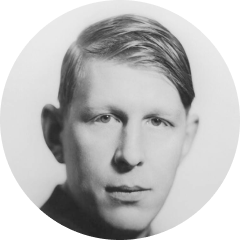W. H. Auden
(1907–73)
W. H. Auden (1907–73): poet, playwright, librettist, translator, essayist and editor. He was educated at Gresham’s School, Holt, Norfolk, and at Christ Church, Oxford, where he co-edited Oxford Poetry (1926, 1927), and where his friend Stephen Spender hand-set about thirty copies of his first book, a pamphlet entitled Poems (1928). After going down from Oxford with a third-class degree in English in 1928, he visited Belgium and then lived for a year in Berlin. He worked as a tutor in London, 1929–30; as a schoolmaster at Larchfield Academy, Helensburgh, Dunbartonshire, 1930–2, and at the Downs School, Colwall, Herefordshire, 1932–5.
Although Eliot turned down his initial submission of a book of poems in 1927, he would presently accept ‘Paid on Both Sides: A Charade’ for the Criterion; and Eliot went on to publish all of Auden’s books at F&F: Poems (featuring ‘Paid on Both Sides’ and thirty short poems, 1930); The Orators (1932); Look, Stranger! (1937); Spain (1937); Another Time (1940); New Year Letter (1941; published in the USA as The Double Man); The Age of Anxiety (1947); For the Time Being (1945); The Age of Anxiety: A Baroque Eclogue (1947); Nones (1952); The Shield of Achilles (1955); Homage to Clio (1960); About the House (1966). Eliot was happy, too, to publish Auden’s play The Dance of Death (1933), which was performed by the Group Theatre in 1934 and 1935; and three plays written with Christopher Isherwood: The Dog Beneath the Skin (1935), which was performed by the Group Theatre in 1936; The Ascent of F6 (1936); On the Frontier (1937). In 1935–6 Auden went to work for the General Post Office film unit, writing verse commentaries for two celebrated documentary films, Coal Face and Night Mail. He collaborated with Louis MacNeice on Letters from Iceland (1937); and with Isherwood on Journey to a War (1939). His first libretto was Paul Bunyan (performed with music by Benjamin Britten, 1941); and in 1947 he began collaborating with Igor Stravinsky on The Rake’s Progress (performed in Venice, 1951); and he co-wrote two librettos for Hans Werner Henze. Other works include The Oxford Book of Light Verse (1938); The Enchafed Flood: The Romantic Iconography of the Sea (1951); The Dyer’s Hand (1963); Secondary Worlds (1968).
Cyril Connolly, ‘Poet and privacy’, Sunday Times, 18 Aug. 1974 (on T. S. Matthews’s Great Tom: Notes towards the definition of T S Eliot): ‘Auden told me that he got on particularly well with Eliot because he knew how to tease him and there were very few people who dared. Great men like to be teased as large predators like to be scratched.’ See further Humphrey Carpenter, W. H. Auden: A Biography (1981); Richard Davenport-Hines, Auden (1995); Edward Mendelson, Early Auden (1981), Later Auden (1999); David Collard, ‘More worthy than Lark: a television tribute to T. S. Eliot, by W. H. Auden and others’, TLS, 9 Mar. 2012, 14; The Complete Works of W. H. Auden: Poems I & II, ed. Edward Mendelson (Princeton 2022).
